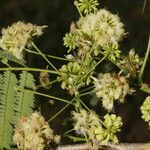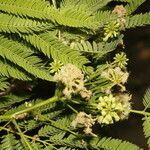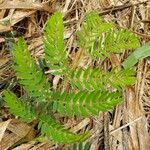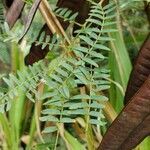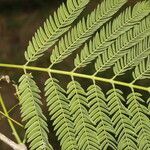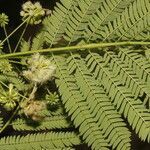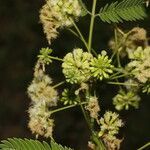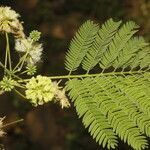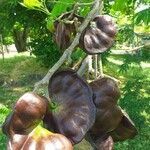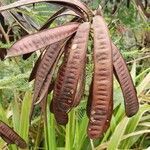Spreading tree, often very large and buttressed on the trunk, the branchlets puberulent to glabrous, smooth. Leaves moderate, twice compound, few-ranked; petiole up to about 8 cm. long, subterete, swollen basally, glabrous or somewhat puberulent, bearing an ovoid gland on the upper side usually near the middle; rachis up to 15 or more cm. long, shallowly sulcate and submarginate above, glabrous or somewhat puberulent, bearing subcupular glands between the terminal and usually penultimate insertions of the pinnae; pinnae 4-15 pairs, opposite on the rachis, the pinnular rachis with sessile or partly sunken, oblong, concave glands near insertion of the terminal 1-4 pairs of leaflets; leaflets 15-30 pairs, opposite, small, inequilaterally oblong or oblong-subfalcate, 8-15 mm. long, obliquely rounded basally, obliquely acute-mucronate apically, subglabrous and dark above, appressed-puberulent and lighter below, the costa excentric; stipules not evident. Inflorescence of 1-3 pedunculate heads from several foliate or (more frequently) defoliate nodes of the young branchlets; peduncle 2-4 cm. long, puberulent or subglabrous; head globular, 10-15 mm. in diameter, multiflorate; bracts minute. Flowers small, sessile, whitish; calyx short tubular-campanulate, about 3 mm. long, puberulent or subglabrous on the tube, canescent-tomentulose on tips of the lobes, valvate in bud; corolla tubular-funnelform, 5-6 mm. long, subglabrous except canescent-tomentulose toward the tip, valvate in bud; stamens many, up to 12 mm. long, filaments united into a staminal tube for about half their length; anthers quadrangular, unappendaged; ovary glabrous, subsulcate laterally; style about equalling or slightly exceeding the stamens. Legume reniform, about 10 cm. across and 3-6 cm. wide, compressed, glabrous, lustrous, curved into a nearly complete circle.
More
Trees, unarmed, deciduous, large, 10-20 m tall; crown spreading, thin. Young branchlets, leaves, and inflorescences white pubescent. Stipules caducous, small; petiole and rachis with glands; pinnae (3 or)4-9 pairs; leaflets 12-25(-30) pairs, subsessile, falcate-lanceolate, 8-14 × 3-6 mm, both surfaces sparsely pubescent, midvein close to upper margin, base truncate, apex mucronate. Heads globose, 1-1.5 cm in diam., fasciculate or in racemes. Flowers greenish or white. Calyx ca. 3 mm, calyx and corolla pubescent. Corolla ca. 6 mm. Stamens numerous, basally connate into a tube. Legume black-brown, curved, auriculate-reniform, 5-7 cm in diam., fleshy, both ends rounded, indehiscent. Seeds 10-20, arranged in 2 rows, dark brown, shiny, narrowly ellipsoidal, ca. 1.5 cm, hard. Fl. Apr-Jun, fr. Oct-Dec.
A deciduous tree. It grows up to 30 m high. It has a large stocky trunk. It has small buttresses. The branches are heavy. The leaves are twice divided and feather like. They are deep green and there are 24 pairs of small leaflets and 50 larger leaflets. The flowers are small and greenish white. They occur in heads 1.5 cm across. The fruit is an ear shaped pod. It is 10 cm across and flat and coiled. It has several seeds.
Calyx c. 2.5 mm, pubescent especially at the apex of the lobes
A tropical plant. It is native to tropical America. It grows in dry, lowland forest and savannah. It can tolerate drought. It has some salt tolerance. In Costa Rica it grows from sea level to 1,300 m altitude. It can grow in arid places.
More
A climax, dominant species in subtropical, dry forest zones, restricted to disturbed areas in wetter forest types. Dry lowland forests and savannahs. Dry hillsides and by streams, usually below elevations of 300 metres in Guatemala.
